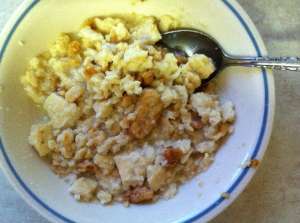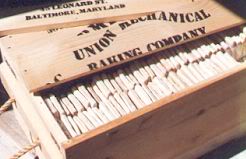Well on my adventure to find the “perfect” picture of what the Union soldiers called Skillygalee I came up empty. As this has never happened to me before, I am quite dismayed by this. HOWEVER, we are in luck that I am persistant. Through many hours of this link, leading to that link, and so on, I was able to find some pictures that I think will give you a pretty good idea of what the Union was cooking up.
Here are some pictures of what I was able to find. I think you will agree, it doesn’t look to bad, and almost appealing to the appetite. I think I would soon begin to cringe at the sight of it, as it was nearly a daily staple for the Union soldiers in the field.
Picture courtesy of TimeTravelKitchen
For a much-needed change of pace from the “worm castles” that were often received by the Union soldiers, they made Skilligalees. Now I’m not sure if this was from self-preservation or because they wanted a change in diet. I’m guessing that these options were essential in the prevention of starvation. As rations weren’t always delivered in a timely manner, by the time soldiers received their hardtack it was often infested with weevils and other undesirable critters. Facing either feast or famine, the hardtack was often seen as undesirable to eat. Yet the ingenuity of the Union soldiers most likely saved them from the latter of the choices they faced.
Union rations Hardtack Box pictures courtesy of Soonerfans.com
The soldiers would break up the hardtack and soak it in hot water, one to make it softer to eat. And the other, to kill the critters that didnt’ really want to share. Now I don’t want to discourage you here, and I definitely don’t want to kill your appetite either. But here is what they often did to salvage the hardtack. They would break up the hardtack and soak it in hot water. Soon, the critters would drowned and float to the top. They would scoop (or by some other means) off the weevils or whatever else floated to the top, then drain the water. Have you ever seen a soggy cracker? Quite possible in the attempt to save the hardtack for consumption they came up with Skillygalee to dry it back out.
After “washing” the hardtack, the soldier would add other things (salt pork, brown sugar, or molasses) to it, making it more appealing to the palette.
Here is the recipe for the Skillygalee.
Union Skillygalee:
- Hardtack, broken into small chunks
- Water
- Salt Pork
- Bacon grease
Break up hardtack into small chunks in the bottom of a tin cup.
Soak hardtack for 10-15 minutes or until soft. (Don’t forget to drain off the floaties!! :p)
While hardtack is soaking, fry up some salt pork. After frying chop into small pieces.
Dump soaked hardtack pieces into grease remaining in skillet, canteen half, tin-can,or tin-cup. Return the chopped salt pork to the skillet also.
Fry this until heated through.
Remove from heat and eat.
Recipes: HARDTACK:WORLD’S FIRST ORIGINAL SURVIVAL FOOD
RED CROSS WAR CAKE (TRENCH CAKE): WWI SURVIVAL FOOD
HOW TO MAKE PEMMICAN – THE ULTIMATE SURVIVAL FOOD
♥ Recipe courtesy of 26nc.org. It is of no doubt that the Civil War was one of hard times, and hard choices. I know I’ll never look at a cracker the same way again!
Source: loweryleather.wordpress.com
Here’s just a glimpse of what you’ll find in The Lost Ways:
From Ruff Simons, an old west history expert and former deputy, you’ll learn the techniques and methods used by the wise sheriffs from the frontiers to defend an entire village despite being outnumbered and outgunned by gangs of robbers and bandits, and how you can use their wisdom to defend your home against looters when you’ll be surrounded.
Native American ERIK BAINBRIDGE – who took part in the reconstruction of the native village of Kule Loklo in California, will show you how Native Americans build the subterranean roundhouse, an underground house that today will serve you as a storm shelter, a perfectly camouflaged hideout, or a bunker. It can easily shelter three to four families, so how will you feel if, when all hell breaks loose, you’ll be able to call all your loved ones and offer them guidance and shelter? Besides that, the subterranean roundhouse makes an awesome root cellar where you can keep all your food and water reserves year-round.
From Shannon Azares you’ll learn how sailors from the XVII century preserved water in their ships for months on end, even years and how you can use this method to preserve clean water for your family cost-free.
Mike Searson – who is a Firearm and Old West history expert – will show you what to do when there is no more ammo to be had, how people who wandered the West managed to hunt eight deer with six bullets, and why their supply of ammo never ran out. Remember the panic buying in the first half of 2013? That was nothing compared to what’s going to precede the collapse.
From Susan Morrow, an ex-science teacher and chemist, you’ll master “The Art of Poultice.” She says, “If you really explore the ingredients from which our forefathers made poultices, you’ll be totally surprised by the similarities with modern medicines.” Well…how would you feel in a crisis to be the only one from the group knowledgeable about this lost skill? When there are no more antibiotics, people will turn to you to save their ill children’s lives.
And believe it or not, this is not all…
Table Of Contents:
How North American Indians and Early Pioneers Made Pemmican
Making Your Own Beverages: Beer to Stronger Stuff
Ginger Beer: Making Soda the Old Fashioned Way
Spycraft: Military Correspondence During The 1700’s to 1900’s
Wild West Guns for SHTF and a Guide to Rolling Your Own Ammo
How Our Forefathers Built Their Sawmills, Grain Mills,and Stamping Mills How Our Ancestors Made Herbal Poultice to Heal Their Wounds
What Our Ancestors Were Foraging For? or How to Wildcraft Your Table
How Our Ancestors Navigated Without Using a GPS System
How Our Forefathers Made Knives
How Our Forefathers Made Snow shoes for Survival
How North California Native Americans Built Their Semi-subterranean Roundhouses
Our Ancestors’Guide to Root Cellars
Good Old Fashioned Cooking on an Open Flame
Learning from Our Ancestors How to Preserve Water
Learning from Our Ancestors How to Take Care of Our Hygiene When There Isn’t Anything to Buy
How and Why I Prefer to Make Soap with Modern Ingredients
Temporarily Installing a Wood-Burning Stove during Emergencies
Making Traditional and Survival Bark Bread…….
Trapping in Winter for Beaver and Muskrat Just like Our Forefathers Did
How to Make a Smokehouse and Smoke Fish
Survival Lessons From The Donner Party
Get your paperback copy HERE
Second edition of the book available now. Get yours HERE
WHAT TO READ NEXT:
HOW TO MAKE YOUR OWN BACON (STEP BY STEP GUIDE)
A RETURN TO THE OLD PATHS: HOW TO MAKE PEMMICAN LIKE THE NATIVE AMERICANS
20 LOST RECIPES FROM THE PIONEERS: WHAT THEY COOKED ON THEIR JOURNEY WESTWARD
SEVEN CLASSIC GREAT DEPRESSION ERA RECIPES GRANDMA USED TO MAKE
POTTED MEAT: A LOST SKILL OF LONG TERM MEAT STORAGE
BACK TO BASICS: HOW TO MAKE AND PRESERVE LARD
THE BEST WAY TO STOCKPILE VEGETABLES OFF-GRID
OLD FASHIONED PRESERVING-GRANDPA’S RECIPE FOR CURED SMOKED HAM
HOW TO MAKE GUNPOWDER THE OLD FASHIONED WAY
SURVIVAL HERBAL RECIPES FROM OUR ANCESTORS
HOW TO PRESERVE MEAT FOR SURVIVAL LIKE OUR GRANDFATHERS
OTHER USEFUL RESOURCES:
The 3 Pioneer Survival Lessons We Should Learn
The Most Effective Home Defense Strategies
Old School Hacks for Off-Grid Living
The Medical Emergency Crash Course



